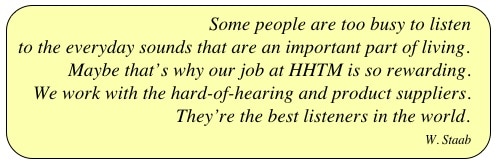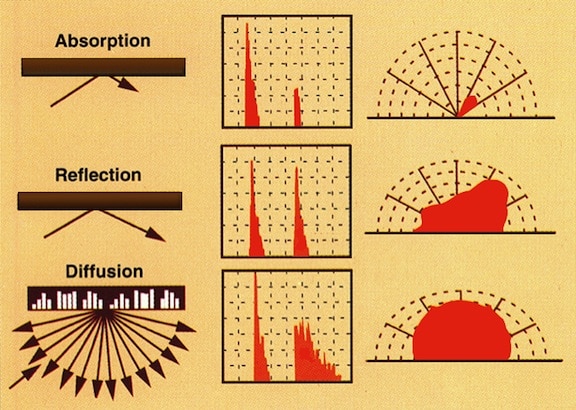How Room Acoustics Affects Hearing Aid Performance

A room’s acoustics are often blamed for poor intelligibility, especially for persons wearing hearing aids. But, what does this inanimate enclosure do to warrant this scorn?
To answer this, it is helpful to know what the room does with the sounds produced in the room in terms of general expectations. We need to be aware also that spurious sounds can contribute to poor intelligibility on their own.
This short post is provided as a starting discussion only and is presented in a graphic primarily. The serious student will refer to expert references on this topic. However, a few basics help to provide some understanding as to how the room affects intelligibility. That is the goal of this post.

Figure 1. Sound production generation in free space and indoors (enclosed rooms), illustrating the impact that the “boundaries” have on the sound propagation. In free space, distance and the inverse square law dominate this, but indoors, numerous factors come into play, having a significant impact on intelligibility.
Figure 1 is a general outline of how sound propagation is affected by sounds produced in free space (outdoors in yellow), and indoors (in blue).
Free Space (Air without hard objects nearby)
Sound emitted from a talker or loudspeaker decreases with distance from that source. The reduction rate is 6 dB (1/2 amplitude or 1/4 energy and intensity) per distance doubled. Common rooms significantly alter this simple picture.
Small Rooms/Large Rooms
Living rooms, offices, etc. generally have pleasant acoustics. Large rooms, on the other hand, will noticeably distort sound through one or more of these mechanisms:
- Reflection
- Delay
- Selective absorption
- Diffusion (dispersion)
Reflection – Hard surfaces will reflect sound back into the room (Figures 3 and 4). This could be a flat wall, a façade of a balcony, or the room ceiling itself. Typical treatments to remove reflections include the movement of objects in the room, or the utilization of some kind of absorption material.
Reflections can be characterized as follows:
- 0 msec- 20 msec Natural, brilliant
- 20 msec – 50 msec Fuzzy, muddy
- 50 msec – 100 msec Reverberant
- 100 msec + Echoes
The sound we hear in a room is a combination of the direct sound emitted by a source and the indirect reflections from the room boundaries. The indirect reflections arrive at a given point at discrete times that are related to their travel paths. The amplitude, arrival time, temporal distribution, and directionality of these indirect reflections determine how we perceive the actual sound source.

Figure 2. The “liveliness” of a room depends upon the time that it takes for a direct sound, upon cessation, to drop to a level of 60 dB below its original level.
Rooms are often described also as being acoustically “live” or “dead.” When a room has a long reverberation time, it is said to be a “live” room, and when the sound reflections die rapidly, the room is considered a “dead” room (Figure 2).
The time for reverberation to completely die away depends on how loud the sound was to begin with, the absorption or reflection of the room, size of the room, and the acuity of the hearing of the listener, among other things. In order to provide a reproducible parameter, a standard reverberation time has been defined as the time for the sound to die away to a level 60 dB below its original level.
Why 60 dB? This level is arbitrary, but there is some rationale for using 60 dB, because the loudest crescendo for most orchestral music is about 100 dB and a typical room background level for a good music-making area is about 40 dB. Thus, the standard reverberation time is seen to be about the time for the loudest crescendo of an orchestra to die away to the level of the room background. The 60-dB range is about the range of dynamic levels for orchestral music.
Delay – Echoes are delayed sound reflections. The effect of an early echo depends on its sound level, its delay, and the sound processing algorithms in our brain (recall that we hear with our brain, not our ears). In a small room, reflected sound returns so quickly that our brain perceives it as one and the same sound.
Early echoes: Experts in speech intelligibility agree that echoes arriving at the ear within about 20 msec (1 second is a thousand milliseconds) of the direct sound from the same source are also perceived by the brain and inner ear as one and the same sound, syllable by syllable (although the exact time delay acceptable is the subject of considerable ongoing research).
Late echoes: For complex sounds, such as speech, a late echo whose level is 20 dB or more lower than that of the direct sound will be ignored by the brain. The resultant impact on masking the direct sound under this condition is termed forward masking.
When the level of a late echo equals that of the direct sound from the same talker, the brain becomes confused, and reduced intelligibility results.
If the late echo level is 10 dB or more greater than that of the direct sound, the brain will accept the late echo as the primary sound and will ignore the earlier direct sound. This is called backward masking.
It should be obvious that the less delay (including the sound level) of the reflected sound that reaches the ear, the better it is for speech intelligibility. Part of the intelligibility loss for individuals wearing hearing aids in reverberant rooms is due to the vowel formants (especially their fundamental frequency, or lowest frequency component) that when reverberating with long, and high level echoes, tend to mask the consonant sounds that follow.
Selective Absorption – Sound absorption treatment is used in some select large room locations (primarily theaters and/or musical venue locations) where considerable cost has been expended to reduce echoes by providing materials to absorb some frequencies – some better than others. This is not a topic for this post. And, regardless, the hearing-impaired user has little or no influence over large rooms, whether designed well or poorly (mostly poorly).
Diffusion – This is an excellent alternative or complement to sound absorption because this effect does not remove sound energy, but can effectively reduce distinct echoes and reflections while still leaving a live-sounding space. Diffusion causes sound energy to be radiated in many directions, hence leading to a more diffusive acoustic space. Reflections are spread in time as well as spatially.

Figure 3. Direct sound, reflection (first order), absorption, and diffusion expectations relative to room acoustics.
In small rooms, the situation can be different – often occurring more by accident than by design. Carpeting, drapes, thick wood, soft chairs, and smaller size often combine to reduce reflections resulting in late echoes, but not always.

Figure 4. An emitted sound is changed when it reaches the boundaries of a room, in the time domain (center) and in space (right).
Spurious Noises
Other disturbing background sound levels can be produced by room equipment: computers, ventilation heating and air conditioning fans, and outside noises that penetrate the room (traffic, aircraft, adjacent rooms with poor noise insulation, etc.). Such noises always reduce the intelligibility of speech distributed in these rooms.






I appreciate the data provided here about the qualitative effects of different reverberation times. To my mind, we ought to be paying *much* more attention to acoustics when we design or choose new spaces to spend time in. Currently, however, “open concept” design in new homes or in renovations is quite popular, with little or no apparent thought given to how the reverberation from different activities will make it much harder for people to understand conversation or simply escape undesired background noise. Perhaps we need to look for flexible options that will let us maximize our sight lines if desired while also letting us reduce unwanted noise.
A good Acoustics 101 explanation! Thank you.
Small room acoustics can usually be improved for intelligibility fairly easily. While not an acoustically critical area in our home, the difference in our 10′ x 5′ bathroom is noticeably different with a shower curtain than without a shower curtain.
In a larger venue, e.g. concert hall, church or auditorium, it takes a lot more than a shower curtain to make a difference. Large venues, such as an auditorium, church or concert hall, may also have a specific need to be more live, e.g. for music. Speech, on the other hand, needs a less live room. Thus, we may have opposing needs in a venue, depending on the program content. For people with hearing loss, intelligibility is significantly improved with an assistive listening system – and most significantly with a hearing loop.
While it is certainly true that some rooms are easier to hear in than others, the big problem for those with the Cocktail Party Syndrome is that their ears do not hear as well as other people’s in background noise. This problem is more effectively addressed with Sound Therapy. https://soundtherapy.com.au/how-it-helps/tinnitus-and-hearing/how-sound-therapy-helps-tinnitus-and-hearing/background-noise/
So glad to read this article on room acoustics and HA performance. Great reminder to those of us who dispense hearing aids and counsel our patients on realistic expectations. So many times I deliver hearing aids in my 10X10 carpeted office with acoustic ceiling tile and hear the wow factor only to have them return in a week confused about how horrible they hear in their own homes with cathedral ceilings and wood or tiled floors. I believe it is so important to bring awareness to our patients pertaining to room acoustics. A reminder to myself to include this in my “realistic expectations” speech on delivery.